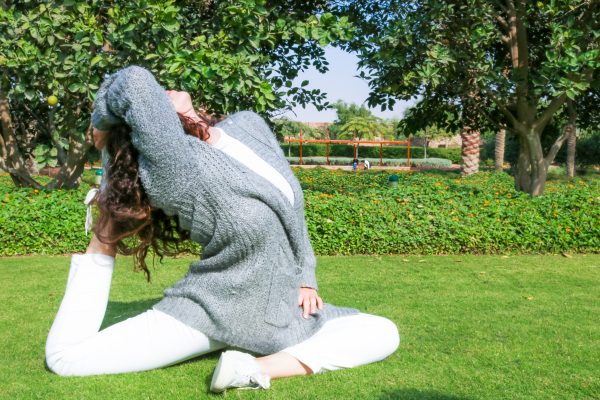By: Nesrien Abdelkader
@NesrienAshraf
The practice of yoga, a physical, mental and spiritual disciplines to improve wellbeing, dates back thousands of years to India and includes many different types such as ashtanga, vinyasa, hatha and yin yoga. It is more than just a pastime for those who practice the ancient art – it’s a lifestyle used to achieve happiness and inner peace.
According to the American Osteopathic Association, yoga provides physical benefits such as increased flexibility and muscle strength as well as improved respiration, energy and vitality. One of its greatest mental benefits is stress management.
AUC Sports Complex Yoga Instructor Rana Hafez defines it as the balance in her life, whether it’s physical or mental.
“Yoga controls the fluctuations of the mind. Yoga is balance and patience. It’s a concept that you use in your daily life, not just in class,” she said.
Hafez explained that yoga provides a different purpose for everyone and the type of yoga as well as how often an individual should practice depends on what they want to get out of the ancient art. For example, hatha yoga would be better for individuals looking to improve a certain muscle group whereas other types focus more on flexibility, patience or breathing.
She added that yoga moves one’s mind and body as opposed to regular workouts at the gym. It goes deeper and changes one’s whole perspective on life.
“I became calmer and I have more patience. The communication and interaction between me and my students is beyond description. Now I know how to heal my mind, body and soul through yoga meditation,” Hafez said.
According to the US National Center for Complementary and Integrative Health, yoga can aid in managing anxiety from everyday situations and can improve habits such as eating, sleeping and smoking.
The American College of Physicians also recommends yoga as a treatment for chronic lower back pain.
But does it make you happy?
Yes, says Architecture alumna Martina Mina, who tries to finish at least 15 minutes of yoga even on her busiest days.
“I practiced twice a week during the semester and because of my tight schedule and academics, I went to the yoga classes at university. Currently, I practice almost everyday. I am more committed ever since I graduated,” she said.
Mina initially started practicing yoga seriously in order to gain control over her life and ease the stress that came along with her architecture courses.
“I was slightly losing connection to myself and was accepting that life is all about the projects that I should drain myself for. I pushed myself to attend classes and be committed to this again, to have something to look forward to during the week,” Mina said.
Mina was able to feel happy despite all her troubles as soon as she got the chance to get back to her yoga studio.
“I remember running to the aerobics room from the [architecture] department with 100 things in mind and to-do lists, but once I step foot on the mat I’m focusing on me; everything starts to slow down, I breathe deeply and relax,” she said.
Mina adds that yoga and meditation, which she has recently started, are an essential part of her life now.
“It truly makes me happy, and I’m glad I opened up to it. There’s a light mood that takes over whenever you roll your mat and start flowing; you become more lightweight,” she said.
Outside of AUC, yoga is being taken seriously throughout Egypt with many people practicing and promoting it.
Yoga studios have popped up across Cairo in areas such as Zamalek, Maadi, New Cairo, Heliopolis, and more. Some popular sites include Yalla Yoga and On the Mat Studio.
Yogi and influencer Amira Ayman’s Instagram profile is full of aesthetically pleasing photos. Followers see her doing yoga on the beach or meditating in a garden, but what many people don’t realize is that it’s more than a few pretty pictures for Ayman – it’s a lifestyle.
Ayman began practicing yoga in 2014 to overcome personal trauma and a back injury. Since then, she has become a more open and tolerant person. She feels calmer and views the world with a more positive mindset now.
“Mostly, my personal practice is mindful movement depending on what my body feels like. I let it guide me. The most important thing is that the real yoga is off the mat, so every living moment, I try to practice the yoga of the heart, mind and soul,” Ayman said.
She added that any form of yoga can activate the parasympathetic nervous system, which is responsible for people’s rest and digestion modes. It helps people heal and become more peaceful, kind and compassionate.
“Yoga and movement aid in the production of many good hormones and these good hormones are basically the key to happiness,” she said.
Ayman embraces her spirituality through other methods such as meditation, chanting and healing sessions.
“Spirituality is also in the way we live in general. It’s in the way we deal with other people, animals, objects – yes, even a chair – and the nature around us. It is being part of this nature,” she said.
Malak Sekaly, a political science alumna, has been practicing vinyasa yoga regularly for over two years and has felt positive impacts on both her mind and body.
“It definitely does decrease my stress levels. When you talk about yoga, it’s not only the physical aspect but it’s also a lot of physical and mental relaxation. Vinyasa flows are guided by breathing and once you control your breath it calms down your entire body,” Sekaly said.
Sekaly has fallen so in love with it that she has decided to start a yoga instructor training course in the next few months.
